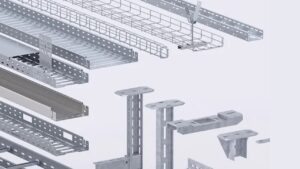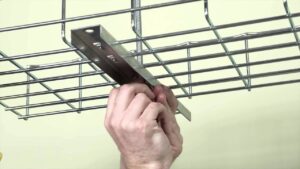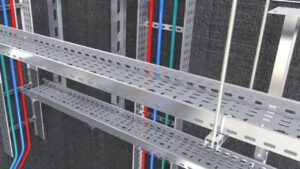
Cable tray systems are essential for organizing and supporting electrical cables in various settings, ensuring safety and efficiency. It is essential to install systems correctly to avoid risks, preserve system integrity, and make maintenance easier. You may guarantee that your projects have a safe, dependable, and efficient cable management system according to these recommendations.
Understanding Cable Tray Systems
Cable Trays are a lightweight structural electrical support device that provides protection against fire buildup and overheating while facilitating the safe harnessing and transportation of cables and electrical flexible conduits across open spans. Cable trays are rigid structures used to support the cables. The National Electrical Code (NEC) specifies the cable tray type to use. Cable trays are capable of supporting the following wiring variants, such as high voltage power lines, power distribution lines,optical lines, and telecom and control lines
Types of Cable Trays

1. Ladder type cable tray:
Ladder cable trays provide a stable and easily accessible cable platform. This design supports a wide range of cable types and simplifies installation and maintenance.
2. Perforated cable tray:
Perforated cable trays have several holes in their bottom, providing excellent ventilation and preventing the accumulation of heat. This design feature is vital in environments where maintaining a lower temperature around cables is necessary to ensure the safety and efficiency of electrical systems.
3. Solid bottom cable tray:
Solid bottom cable trays are the recommended option for working in areas that require strict electromagnetic interference (EMI) protection. These cable trays consist of ventilated or solid bottoms contained within longitudinal side members.
4. Channel cable tray:
Channel cable trays have powder-coated, hot-galvanized, and electro-galvanized surfaces mainly used to support computer cables, communication cables, thermocouple cables, and other control cables.
Materials used in making a cable tray

1. Metallic Cable Tray:
Material used:
-
Aluminium: Aluminium is lightweight. It offers an excellent strength-to-weight ratio. It is Corrosion-resistant
-
Steel: It is electric shielding and low thermal expansion.
-
Stainless Steel: It has High corrosion resistance and is Applicable for high-temperature ranges.
2. Non-metallic Cable Tray:
Material used:
- Fiberglass: They are nonconductive, corrosion-resistant, and lightweight.
3. Galvanized Trays:
Material Used:
- Pre-galvanized steel sheet fabricated into the tray
- Hot dip galvanized after fabrication.
Installation Steps

- Step 1:Planning and Design:
1. Evaluation of Cable needs:
Choose the cables that need to be routed through the cable trays and how many of each type.It is important to consider that additional cables may require future growth.
2. Arrangement and Direction:
Optimize the routing to prevent disruptions to other devices and systems.
3. Load capacity:
Determine the total weight of the cables and select cable trays that can hold them without sagging by measuring their load-bearing capacity.
- Step 2: Selecting the right Cable tray:
Choosing the appropriate cable tray type and material is crucial to meet the specific requirements of the installation.
1. Environmental Conditions:
For harsh environments or corrosive atmospheres, select materials like stainless steel or fiberglass that offer superior resistance to corrosion.
2. Cable Tray Type:
Decide on the ideal cable tray type based on the application – ladder, solid bottom, wire mesh, trough, or channel.
- Step 3: Preparing the installation site:
1. Organizing and clearing:
Clear the space where the cable trays are going to be installed of any dust, debris, or other obstructions that might make things more difficult.
2. Measurements and Markings:
Mark the locations of the cable trays with the required marking instruments. To prevent misalignment, double-check your measurements.
- Step 4: Mounting the Cable Tray:
The mounting process requires precision and attention to detail. Follow these steps:
1. Attach Wall Brackets:
If the cable trays will be wall-mounted, fix the brackets securely to the wall using suitable anchors and screws.
2. Align and Level :
Ensure that the brackets are properly aligned and leveled to avoid any slant in the cable tray.
3. Secure the cable Tray:
Place the cable tray onto the brackets and secure it tightly using nuts and bolts. Ensure that it is level and stable.
- Step 5: Cable Installation:
1. Cable Support:
To stop the cables from sagging, arrange them inside the cable tray and utilize the necessary supports, like clamps or cable ties.
2. Separation and Packing:
Sort and arrange cables according to their kind and purpose to reduce interference and make maintenance easier.
- Step 6: Grounding and Bonding:
For electrical safety, proper grounding and bonding are necessary.
1. Grounding:
To shield against electrical risks and stop the accumulation of static charges, connect the cable trays to the grounding system.
2. Bonding:
Make sure the brackets are level and correctly positioned to prevent any inclination in the cable tray.
- Step7: Final Inspection and Testing:
1. Visual Inspection:
Inspect the cable trays and cables for any damage, misalignment, or loose connections.
2. Load Test:
To ensure that the cable trays can support the weight of the cables without showing any evidence of strain or deformation, do a load test.
Safety Considerations
- Personal Protective Equipment (PPE)
- Hard Hats: Protect the head from falling objects, impacts, and electrical hazards.
- Gloves: Shield hands from cuts, abrasions, chemicals, and extreme temperatures.
- Safety Glasses: Safeguard eyes from dust, debris, chemicals, and potential impacts.
- Risk Management
- Implementing Safety Protocols: Develop and enforce safety procedures, including emergency response plans, proper equipment usage, and regular safety training sessions for all employees.
Maintenance and Troubleshooting
Maintaining cable trays in UAE is excellent working order requires regular maintenance. Preventative maintenance refers to routinely planned maintenance procedures, like cleaning, lubrication, and adjustments, that are intended to stop malfunctions or breakdowns.

- Cleaning: Keeping cable trays clean regularly is a crucial maintenance task. Dust, debris, and dirt buildup on cable trays can cause corrosion and reduced functionality. By clearing debris and enabling a visual inspection of the tray, routine cleaning helps avoid these problems. A moderate detergent solution and a soft brush or cloth should be used for cleaning.
- Lubrication: By lowering friction between moving parts, lubrication aids in the prevention of corrosion and wear. Hinges and locking mechanisms, among other moving elements, should be lubricated with high-quality lubricant.
- Adjustments: To guarantee optimal functioning, cable trays should be adjusted regularly. It could be required to make adjustments to tighten loose nuts or screws or to properly align the tray. Trained individuals should make these modifications, adhering to the manufacturer’s requirements.
- Repair: Repairs have to be done right away if the inspection reveals damage or other problems. Replacing broken parts or fixing corroded regions are examples of repairs. Repairs must be carried out by qualified individuals and according to the manufacturer’s instructions.
Conclusion
Cable trays in UAE are vital for organizing and supporting electrical cables, ensuring safety and efficiency. Safe installation reduces dangers, maintains system integrity, and makes maintenance easier. Types of cable trays, installation guidelines, selection criteria to take into account, and maintenance tips are all included in this article. You may ensure a safe, dependable, and efficient cable management system for your projects by adhering to these principles, which will ultimately promote a more secure and productive workplace.